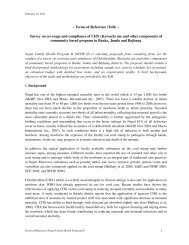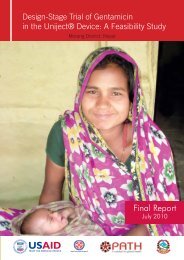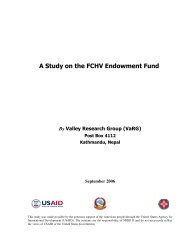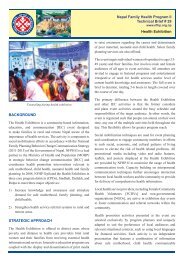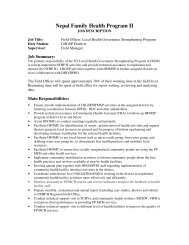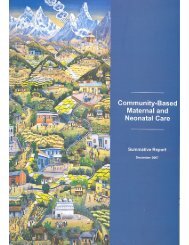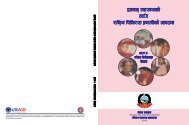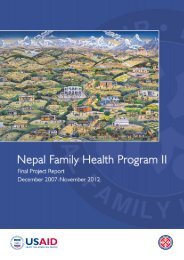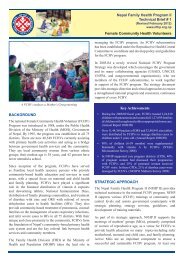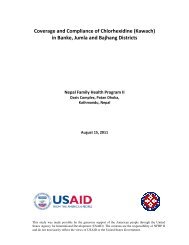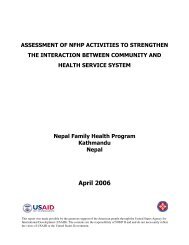PPFP - Nepal Family Health Program II
PPFP - Nepal Family Health Program II
PPFP - Nepal Family Health Program II
Create successful ePaper yourself
Turn your PDF publications into a flip-book with our unique Google optimized e-Paper software.
<strong>Nepal</strong> <strong>Family</strong> <strong>Health</strong> <strong>Program</strong> <strong>II</strong><br />
Technical Brief # 30<br />
www.nfhp.org.np<br />
Strengthening Post-Partum <strong>Family</strong> Planning (<strong>PPFP</strong>)<br />
FP clinics, maternal, neonatal and child health (MNCH)<br />
clinics, maternity wards, post abortion care (PAC), and safe<br />
abortion services (SAS) sites. There is therefore tremendous<br />
opportunity to provide family planning information and<br />
services to postpartum mothers when they visit health<br />
facilities for their MNCH services.<br />
STRATEGIC APPROACHES<br />
A health worker counseling postpartum mother about FP<br />
methods<br />
BACKGROUND<br />
Of the 182 million pregnancies that occur in developing<br />
countries, more than a third are unintended. 1 Two-thirds of<br />
unintended pregnancies occur among women who are not<br />
using a method of family planning, suggesting significant<br />
unmet need. <strong>Family</strong> planning use during the first year<br />
postpartum is low, and one in three women become pregnant<br />
again within 15 months after birth. 2<br />
In <strong>Nepal</strong>, unmet need of FP among postpartum (delivery to<br />
one year) mothers was 38% but increased to 47% between<br />
10-12 months after delivery. In addition only 22% of<br />
postpartum mothers use modern contraceptive methods,<br />
with many placing too much confidence on breast feeding<br />
to prevent pregnancy - even when non-exclusive. <strong>Nepal</strong>ese<br />
women abstain from sexual intercourse for a median of 2.1<br />
months, and 81% of <strong>Nepal</strong>ese women abstain in the first<br />
two months following birth. 3 In India, it was found that the<br />
mean start of sexual activity after delivery was 2.8 months<br />
and 28% of women were sexually active within six weeks<br />
postpartum, rising to 93% by the end of 6 months. 4 These<br />
results clearly show the importance of FP services the during<br />
postpartum period, which can benefit infant and maternal<br />
health through longer intervals between births.<br />
Service providers in <strong>Nepal</strong> have inadequate knowledge<br />
about the FP needs of postpartum mothers and do not focus<br />
on FP counseling during the postpartum period. There is<br />
a lack of referral, coordination and communication among<br />
Strengthening postpartum family planning (<strong>PPFP</strong>) is<br />
a comprehensive maternal, newborn and child health<br />
service approach that has the potential to systematically<br />
reach a large number of women with critical, life-saving<br />
information and services. 5 The main reason behind the<br />
integration of FP and MNCH services is to provide mothers,<br />
at every point of contact with the health system, with an<br />
opportunity to talk about their reproductive intentions, give<br />
mothers information about the benefits of family planning,<br />
and the range of available contraceptives.<br />
The <strong>Nepal</strong> <strong>Family</strong> <strong>Health</strong> <strong>Program</strong> <strong>II</strong> (NFHP) provides<br />
technical assistance to the national family planning<br />
program. To initiate <strong>PPFP</strong> services, NFHP helped the <strong>Family</strong><br />
<strong>Health</strong> Division (FHD) develop the reference manual and<br />
educational materials for a three-day workshop, designed to<br />
enhance knowledge and skills of service providers, improve<br />
contraceptive choices, promote healthy timing and spacing<br />
of pregnancies (HTSP) and integrate FP/MCH services in<br />
intervention hospitals. NFHP assists the FHD:<br />
Design, develop and publish the national <strong>PPFP</strong> program<br />
guidelines, job aids and other educational materials<br />
Create an enabling environment for hospitals to receive<br />
family planning information and services to postpartum<br />
mothers<br />
Establish linkages and coordination mechanisms<br />
between the different wards and departments of<br />
hospitals<br />
Ensure effective monitoring of the <strong>PPFP</strong> program<br />
INTERVENTION SITES<br />
The Strengthening <strong>PPFP</strong> <strong>Program</strong> was initiated in two<br />
hospitals in Parsa and Banke in fiscal year 2008/09. Based<br />
on the lessons learned from these two districts, this approach
was gradually expanded to 8 additional hospitals (Koshi<br />
Zonal, Janakpur Zonal, Mahakali Zonal, Mid Western<br />
Regional, Rapti Sub-Regional, Dailekh district, Kalaiya<br />
district and Rolpa district hospitals).<br />
KEY ACTIVITIES<br />
Conducted three-day <strong>PPFP</strong> strengthening workshops<br />
for all service providers working in FP, maternity<br />
wards, MCH, PAC and SAS sites. The training includes<br />
and highlights the following:<br />
<br />
<br />
Importance of FP and FP counseling in the<br />
postpartum period,<br />
Concept and advantages of HTSP,<br />
Availability of contraceptive methods for<br />
postpartum women,<br />
<br />
<br />
Importance of coordination, collaboration and<br />
referrals among the different FP, MCH, maternity<br />
wards, PAC and SAS units in hospitals, and<br />
Recording and the reporting of the services<br />
provided.<br />
Supported hospitals by providing job aids (pregnancy<br />
rule out aids, effectiveness charts), reproductive health<br />
counseling kits, <strong>PPFP</strong> leaflets, and FP posters.<br />
Established <strong>PPFP</strong> coordination committees in the<br />
hospitals for strengthening coordination and referrals<br />
between the different hospital units and wards through<br />
regular meetings.<br />
Conducted follow-up workshops every six months for<br />
review of progress and updates on family planning.<br />
NFHP staff visited hospitals and carried out technical<br />
support visits, preferably with district FP supervisor/<br />
public health nurse and provided on-site coaching<br />
where necessary.<br />
RESULTS<br />
A total of 240 nursing staff and medical officers received<br />
the three-day training on <strong>PPFP</strong> over the two years of<br />
implementation of the Strengthening <strong>PPFP</strong> program in ten<br />
districts.<br />
Major changes observed after the implementation of the<br />
program were regular availability of IEC/BCC materials,<br />
focused counseling of mothers and husbands on FP and<br />
HTSP principles in maternity wards, availability of family<br />
planning services in MCH clinics, immunization sites, PAC<br />
and comprehensive abortion care (CAC) service sites and<br />
coordination between different wards and service outlets.
Following implementation of the program, service<br />
providers reported increased knowledge on family planning<br />
for postpartum mothers. Comparing the service statistics on<br />
family planning before and after the intervention, the results<br />
reveal the following improvements in 10 hospitals:<br />
The number of mothers who received FP counseling<br />
immediately after child birth in maternity wards<br />
increased significantly from 4% to nearly 44% (Table<br />
1). The results from two districts revealed that it was<br />
73% after two years of implementation.<br />
Table 1. Comparing <strong>PPFP</strong> indicators before and after<br />
the intervention in ten hospitals<br />
PP mothers<br />
who received<br />
FP counseling<br />
among total<br />
deliveries<br />
Before<br />
<strong>PPFP</strong><br />
One<br />
year<br />
after<br />
<strong>PPFP</strong><br />
PPT among<br />
total deliveries<br />
Before<br />
<strong>PPFP</strong><br />
One<br />
year<br />
after<br />
<strong>PPFP</strong><br />
Indicators (as percentage)<br />
PAC clients<br />
who received<br />
FP services<br />
Before<br />
<strong>PPFP</strong><br />
One<br />
year<br />
after<br />
<strong>PPFP</strong><br />
CAC clients<br />
who received<br />
FP services<br />
Before<br />
<strong>PPFP</strong><br />
One<br />
year<br />
after<br />
<strong>PPFP</strong><br />
PP mothers<br />
who received<br />
FP services<br />
after<br />
counseling<br />
Before<br />
<strong>PPFP</strong><br />
One<br />
year<br />
after<br />
<strong>PPFP</strong><br />
4.19 43.65 0.73 1.07 60.74 73.51 72.26 80.3 19.84 31.01<br />
Postpartum tubal ligation (PPT) among the total<br />
number of deliveries in 10 hospitals increased from an<br />
average of 0.7% to 1.2%. It would have been more if<br />
there had been regular availability of trained doctors.<br />
Clients receiving FP services in PAC and CAC<br />
sites increased from 60% to 73% and 72% to 80%<br />
respectively. The FP method mix also changed after<br />
the program - more long acting FP methods were used<br />
after clients were counseled at CAC and PAC sites.<br />
There was also a slight increase in minilaporotomy,<br />
use of IUCD, implants and injectables and a decrease<br />
in vasectomies, use of condoms and pills. The service<br />
provider said that more people would have obtained<br />
implants had the government supplied adequate<br />
numbers of implant on time.<br />
The results revealed that nearly 32% of mothers<br />
accepted FP methods after counseling at IFPSC/<br />
MCH clinics. In Parsa and Banke, the acceptors of FP<br />
methods after counseling increased to more than 40%<br />
after the second year of program implementation.<br />
LESSONS LEARNED<br />
Service providers have inadequate knowledge about<br />
the family planning needs of postpartum mothers.<br />
Continuous orientation and updates on <strong>PPFP</strong> helps<br />
service providers internalize the importance of <strong>PPFP</strong>.<br />
Formation of the <strong>PPFP</strong> coordination committee at the<br />
intervention hospitals has been helpful not only in<br />
strengthening coordination, but also in identifying the<br />
problems and possible solutions.<br />
Although <strong>PPFP</strong> is an important approach in fulfilling<br />
family planning needs of postpartum mothers, it takes<br />
time to get significant results.<br />
CHALLENGES<br />
The existing health management information system<br />
(HMIS) does not record the number of FP counseling<br />
and services provided to postpartum mothers, therefore<br />
it is difficult to ensure uniformity and continuous<br />
monitoring of services at the hospitals.<br />
Service providers working in MCH clinics are busy with<br />
their regular activities – providing FP information and<br />
services in addition to MCH services takes additional<br />
effort and time they often do not have. A strategy should<br />
be developed at the central level to inform managers<br />
and service providers at all levels about the integration<br />
of FP with MCH services.<br />
It has been difficult to sustain regular meetings of the<br />
<strong>PPFP</strong> committee as there is no formal system to bring<br />
together providers from different units.<br />
A majority of women do not receive FP services<br />
immediately after the delivery. Moreover, it is difficult<br />
to track the status of use of FP methods as most do not<br />
come back to the hospital for FP services.<br />
RECOMMENDATIONS<br />
This approach should be expanded to other hospitals<br />
in <strong>Nepal</strong> to fulfill the reproductive health need of<br />
postpartum mothers and her family.<br />
It would be beneficial to develop a simple and effective<br />
registration system by modifying the current HMIS tool<br />
so that service providers feel comfortable recording<br />
and reporting use of FP services and referral services.<br />
Information regarding HTSP should be expanded to<br />
the community level through FCHVs, mother's group,<br />
HFOMCs and other mediums.<br />
It is necessary to incorporate the importance of FP<br />
during the postpartum period in MCH related technical<br />
standards, guidelines, and protocols. This will provide<br />
service providers a sense of ownership over the<br />
integration of FP in MCH services.
<strong>PPFP</strong> services should be expanded to the community<br />
level through health institutions, immunization clinics<br />
and primary health care outreach clinics, thus raising<br />
awareness and promoting the use of FP services for<br />
postpartum mothers.<br />
REFERENCES<br />
1. Guttmacher Institute. “In Brief: Facts on Induced<br />
Abortion Worldwide.” 2008 [August 10, 2011].<br />
Available from: http://www.guttmacher.org/pubs/fb_<br />
IAW.pdf<br />
4. Kunwar S, Faridi MMA, Singh S, Zahra F, Alizaidi<br />
Z. Pattern and determinants of breast feeding and<br />
contraceptive practices among mothers within six<br />
months postpartum. BioScience trends [serial on the<br />
Internet]. 2010; 4(4):Available from:<br />
http://www.biosciencetrends.com/action/ownloaddo c.<br />
php?docid=331<br />
5. McKaig C, Chase R. (2007) Postpartum <strong>Family</strong><br />
Planning Technical Consultation - Meeting Report.<br />
Washington, D.C.: JHPIEGO,Baltim ore, Maryland.<br />
2. Ross J, Winfrey W. "Contraceptive Use, Intention to<br />
Use, and Unmet Need During the Extended Postpartum<br />
Period". 27. 2001;1:20-7.<br />
3. Ministry of <strong>Health</strong> and Population, New Era, Macro<br />
International Inc., 2007. <strong>Nepal</strong> Demographic and<br />
<strong>Health</strong> Survey (DHS) 2006. Kathmandu, <strong>Nepal</strong>:<br />
Ministry of <strong>Health</strong> and Population, New ERA and<br />
Macro International Inc.<br />
The program/research described in this article was supported under the <strong>Nepal</strong> <strong>Family</strong> <strong>Health</strong> <strong>Program</strong> <strong>II</strong> which is made possible by the generous<br />
support of the American people through the United States Agency for International Development (USAID). The contents are the responsibility of<br />
NFHP <strong>II</strong> and do not necessarily reflect those of USAID or The United States Government.<br />
NFHP <strong>II</strong> is implemented by JSI Research and Training Institute, Inc., in partnership with Engender <strong>Health</strong>, Jhpiego, Save the Children,<br />
World Education, Inc., <strong>Nepal</strong> Technical Assistance Group, <strong>Nepal</strong> Fertility Care Center, Management Support Services Private Ltd.,<br />
<strong>Nepal</strong> Red Cross Society, United Mission to <strong>Nepal</strong>, BBC Media Action, Digital Broadcast Initiative Equal Access <strong>Nepal</strong>, <strong>Family</strong> Planning<br />
Association of <strong>Nepal</strong> and Center for Development and Population Activities.



